If you plan to use your iPhone for productivity, then the first thing you may consider is what tool you should use to edit a Word document on it. Although there are a bunch of word processing apps out there, the only two tools you may need are Apple’s own Pages app that comes installed natively on iOS or the Microsoft Word app which is free to use on an iPhone as long as you’re signed in to a Microsoft account.
In this post, we’ll explain how you can edit a Word document on your iPhone using these two apps.
Method 1: Edit Word document on iPhone using Apple Pages
Apple’s native Pages app does a decent job when editing Word files on an iPhone. Since the app is free and comes pre-installed on all iPhones, you may have it ready and accessible for editing your Word documents.
Open Word File on Pages
- Open the Apple Pages app on your iPhone.

- When the app opens, tap on the Browse tab at the bottom.

- On this screen, navigate to the location where you’ve saved the Word document that you want to edit. When you locate the file you want to edit, tap on it to open it inside Pages.

- Pages will now open the document in Reading View. To start making changes to it, tap on Edit at the top right corner.

- When you enter Editing mode inside Pages, you shall see a bunch of tools at the top and above the keyboard.

- You can pinch in and out of the screen to get your desired zoom effect.
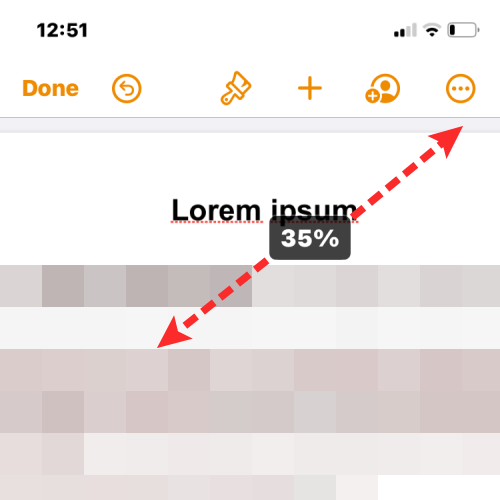
- If you want to edit a document more efficiently, you can switch to Screen View. To do that, tap on the 3-dots icon at the top right corner.

- On the next screen, turn on the Screen View toggle.

- The document will now switch to Screen View with all of its contents made to fit your screen.

Basic editing
For instant editing, Pages offers a handful of options that you can use to tweak your document quickly. The first thing you may want to do while editing a document is select text within it.
- Inside Apple Pages, tap on a word you want to select and this word will get highlighted automatically.
- To expand this selection, drag the cursors on either side of the word until all the words you want to select are highlighted.

- When you make your selection, you will see instant actions at the top. These options will let you cut, copy, delete, and format the selected text. You can access more of these actions by tapping on the arrows at the very end.

- This will reveal more actions you can apply to the selected text including translate, link, bookmark, highlight, comment, and change styles.

- Besides, these actions, you can tweak the text inside your document using the toolbar that appears just above your keyboard.

- This toolbar lets you apply bold, italics, and underline to a selected text or change its alignment to the left, center, right, or justified.

- You can tap on the paragraph icon to tweak how different sections of your document appear.
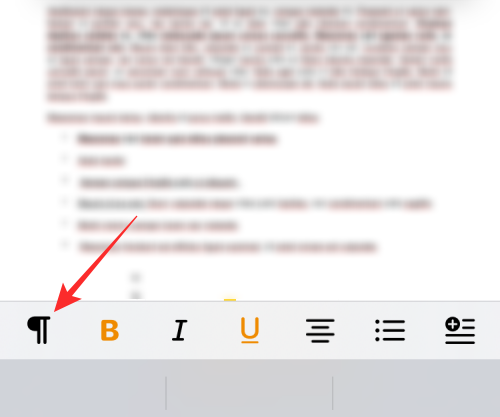
- When you tap on this tool, you’ll see different paragraph styles to apply – title, subtitle, headings 1/2/3, normal, caption, header, footer, and more.

- Additionally, you can use the toolbar to add bulleted or numbered lists by tapping on the List icon.

- You can then select the type of list you want to add and adjust its indent on the next screen.
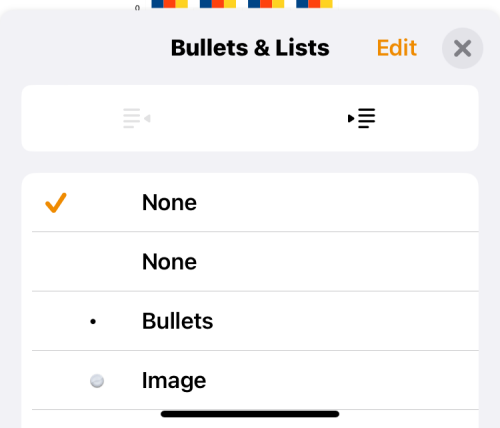
- You can also insert elements into the document by tapping on the Insert icon at the extreme right side of the toolbar.

- When you do that, you will get options to insert tabs, page/line/section/column breaks, page counts, links, bookmarks, footnotes, or tables of contents.
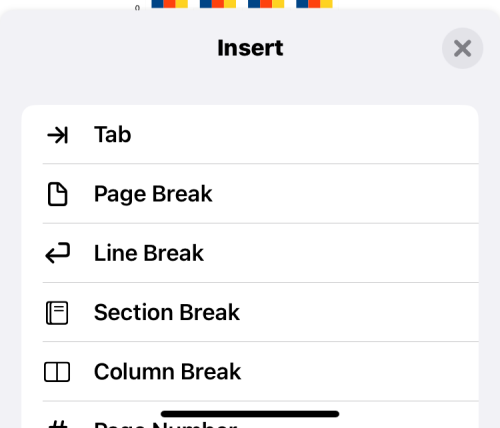
Related: How to Enable or Disable Vibrations on Keyboard on iPhone
Advanced editing
If you want more granular controls to edit your Word document on Pages, you can do that by choosing your required tool from the top toolbar.
Modify text and paragraph formatting
To edit the text inside the document, tap on the paintbrush icon from this toolbar.

You’ll see a Text menu appear at the bottom half of the screen.
Paragraph style:
- If you wish to change how the text in a paragraph appears inside a document, tap on the Paragraph Style box.

- On the next screen, select the style you want to apply to the selected paragraph.

Font type:
- You can change the type of font that’s used in your document by selecting Font inside the Text menu.

- On the next screen, you can choose from several options that you can apply to text.

Bold, Italics, Underline, and Strikethrough:
Underneath font options, you’ll be able to apply different basic text formats like Bold, Italics, Underline, and Strikethrough.

More Text options:
- In the same row as the above option, you can tap on the 3-dots icon to access additional text options.

- In the menu that appears next, you can choose character style, baseline, capitalization, outline, and text background.

Text Size:
Inside the Text menu, you can alter the size of the selected font by tapping the – and + icons next to the size box.

Text Color:
When you tap on Text Color, you can choose a color you want to apply to the selected text inside your document.

Text alignment:
You can tap from the options below to align a paragraph to the left, right, center, or in justified mode.

Bullets & Lists:
- If you wish to add a list to your document, tap on Bullets & Lists inside the Text menu.

- In the options that appear, select the type of list you want to add like bullets, images, lettered, numbered, and more.

Indentation:
To move the selected text to the right or left, tap on the Left Indent or Right Indent icons inside the Text menu.

Line Spacing:
- You can adjust the space taken up by every line in your Word document by tapping on Line Spacing.

- Now, adjust the spacing between, before, and after lines from the next screen.

Columns:
- By default, the text in your document is made to appear in a single column. If you wish to have multiple columns of text on a single page, tap on Columns inside the Text Menu.

- On the next screen, tap on the + icon or – icon to increase or decrease the number of columns in your document respectively.

Drop Cap:
If you want the first letter of a paragraph to be highlighted significantly, turn on the Drop Cap toggle. When you enable this option, you can choose from different styles you can apply to a paragraph.

Related: How to Enable Live Captions on iPhone
Insert an image, video, drawing, chart, table, object, and more
In addition to editing and formatting the text inside a document, you can add more elements to make it more informative and interactive.
- You can insert elements into a document on Pages by tapping on the + button from the top toolbar.

- From the Insert menu that opens, you can add tables, charts, objects, and images to the document.
Tables:
To add tables to a document, tap on the Tables tab at the top. From here, you can choose the table you want to add to your document.

Charts:
- You can add charts to your document by tapping on the Charts tab from the top. When you do that, you can choose the chart that you want to insert from different categories including 2D, 3D, and interactive.

- This is what a chart looks like inside a document on Pages.

Objects:
- The Pages app lets you add any object you want to appear inside a document by tapping on the Objects tab at the top of the Insert menu.

- You can then tap on the object category you want to choose from and select the object you want to insert into the Word file.

Images, videos, and drawings:
- To add images, videos, or drawings, tap on the Image tab at the top of the Insert menu. From this screen, you can add pictures and videos from your iPhone camera or gallery.

- Next, you can capture the content you want to add from the Camera or select it from your library.

- Once selected, you’ll be able to see it appear inside your document.

- Similarly, you can also add equations and drawings to your document by tapping on these options.

- In this instance, we’ve added a drawing with Pages inside your document.

Related: How to Schedule an Email on Apple Mail on iPhone
Method 2: Edit a Word document on iPhone using Microsoft Word
If you’re not satisfied with Apple’s offering, you can always get back to the original and trusted Microsoft Word app. The Word app is available for free on iPhones and iPads that are smaller than 10 inches in size. You can use it to edit anything inside a document in the same way you would do it on a computer as it supports charts, tables, images, equations, footnotes, and more.
Sign in to Microsoft on the Word app
- You can start using the app after you install the Microsoft Word app. Once it’s installed, open the Microsoft Wordapp on your iPhone.

- When the app opens, you’ll see the New screen that lets you create documents from within the app. Since you’re here to edit an existing Word file, you are required to sign in to your Microsoft account to edit a document. If you don’t have one, you can create a Microsoft account for free without any subscriptions as editing controls for Microsoft Word is free on all iPhones.
- To sign in to your Microsoft account, tap the account picture icon at the top left corner.

- In the sidebar that appears on the left, tap on Sign in.

- You’ll need to fill up your account username on the next screen and then tap on Next.

- You can then log in to your Microsoft account after you enter the password you set for the account on the next screen. Once you enter the password, tap on Sign in to proceed.

- You’ll now be logged in to your Microsoft account on the Word app.
Open the Word file to edit
- To start editing a file, tap on the Folder icon at the bottom right corner.

- This will take you to the Open screen where have to select the location of the Word document that you want to edit. If the document is saved inside the Files app on your iPhone, select Files App under “Other Locations”.

- On the next screen, navigate to the folder where the Word document is present. When you land inside the folder, tap on the Word file you want to edit.

- The document will now open up in full view on your screen.

Related: How to Create a Solid Color Lock Screen on iPhone
Basic editing
- To make it easier for you to edit the document, tap on the Layout icon from the top toolbar. This icon lets you toggle between Print Layout and Mobile View. Changing the layout to Mobile View will give you a close-up view of the document making all texts and other elements visible on the screen.

- You can now get started with the editing. The first thing you may want to do while editing a document is select text within it. To select a text inside Microsoft Word, tap on the word you want to select. To select the word, tap on Select above the word you just tapped on. If you want to select the entire document, tap on Select All instead.

- When the word is selected, you can modify the selection to include more or less by dragging the cursors on either side of the word.

- When you make your selection, you will see instant actions at the top. These options let you cut, copy, delete, link, comment, and look up the selected text.

- You can also apply instant formatting options from the toolbar that appears above the keyboard. This toolbar lets you apply bold, italics, and underlines easily.

- You can also add highlight and text colors to selected text by tapping on the Highlight icon or Underlined A icon.
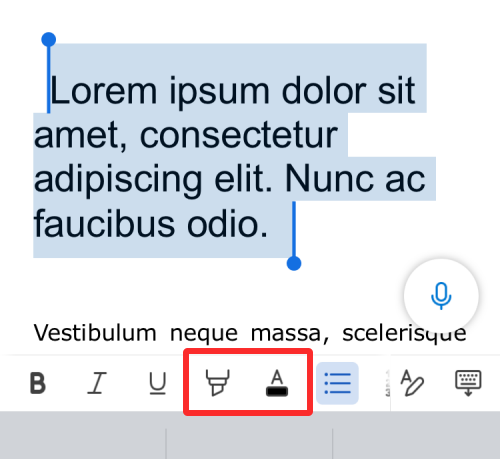
- In the options that appear next, you can choose the color you want to apply to the text or highlight.
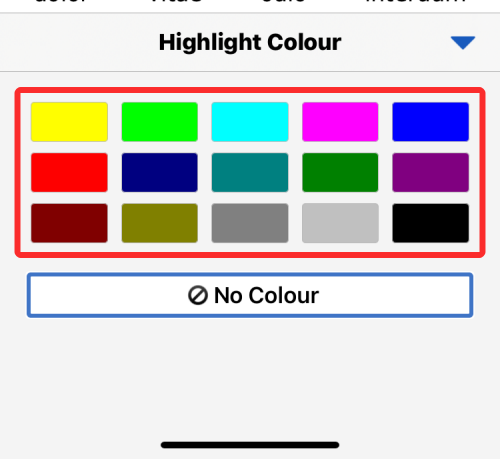
- You can tap on the bulleted list icon or numbered list icon to insert them into your document.

- When you swipe through this toolbar, you’ll get options to indent the text to the left or right by tapping on the Left Indent or Right Indent icons.

- Additionally, you can insert comments, links, images, grids, and tables from the following options.

Advanced editing
- If you want more granular controls to edit your Word document, you can access them by tapping on the Edit Text button (marked by an A and a pencil icon) from the top toolbar.

- When you tap on the Edit Text button, you’ll get a set of tools at the bottom half of the screen. At first, you’ll arrive at the Home tab inside this section.

- To change it, tap on the Home tab or any tab name that’s currently active and then select from the options available.

We’ll explain the options available inside each of these tabs – Home, Insert, Draw, Layout, Review, and View.
Apply text and paragraph formatting
When you’re in the Home tab, you can change the font type, and size, apply text formats, and colors, add bullets, align and indent text, format paragraphs, and more.

Font
- Inside Home, you can change the font type and size by tapping on the applied Font type at the top.

- On the next screen, you’ll see options to change the font and its size.
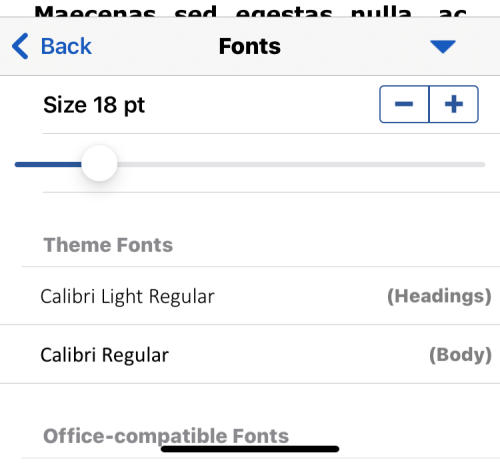
Bold, Italics, and Underline: You can also apply different text formatting by tapping on the Bold, Italics, Underline, and Strikethrough icons inside the Home tab.
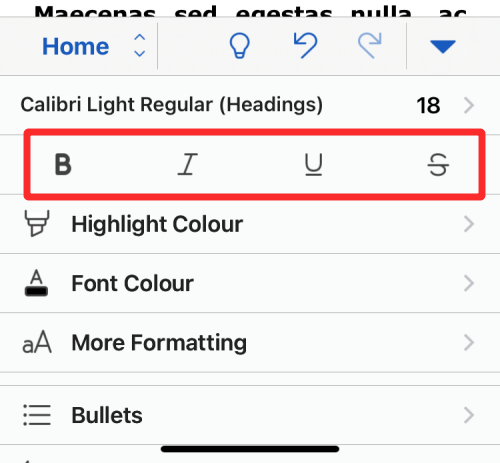
Highlight color: Tap on this section to apply a color to the background of the selected text.
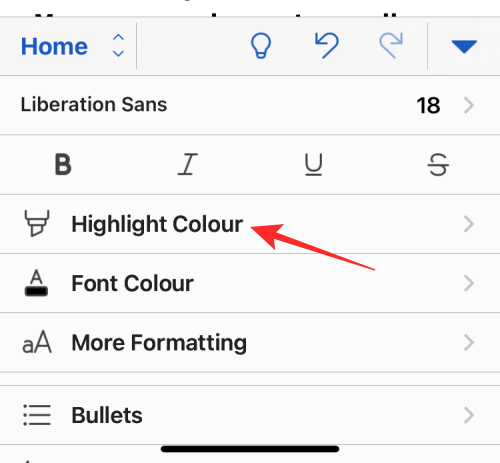
Font Color
- Choose this option to apply your preferred color over the text.

- When you select the option, you’ll see a list of colors to choose from on the next screen.
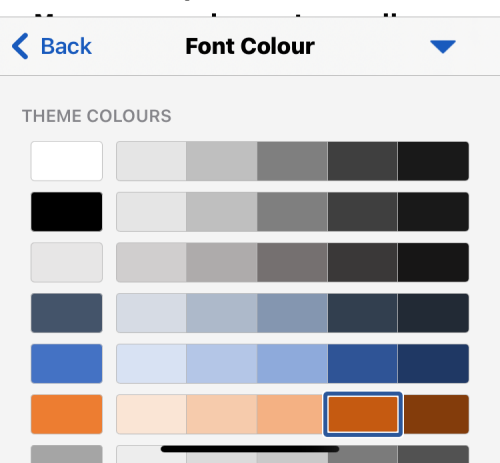
More Formatting: When you choose this option, you’ll get options to add subscripted or superscripted text, change letter cases, apply WordArt styles, and remove any applied formatting.

Bullets
- When you select Bullets, you can add bulleted points to your document.

- On the next screen, you’ll be able to select the shape or design of the bulleted point.

Numbering
- When you choose Numbering, you essentially add a list of points to your document in a numbered format.

- On the next screen, you’ll be able to choose what style of numbers are applied.
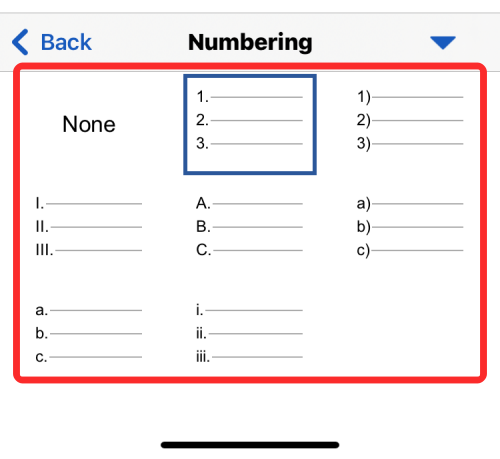
Indent: Tap on the left indent icon or right indent icon to reposition the start of a paragraph to the left or right side.

Align: Choose from the available options to align text to the left/right sides, to the center, or justified.

Paragraph formatting
- Choose this option if you want to tweak what a paragraph looks like.

- Here, you will get options to apply special indent, adjust line spacing, add paragraph marks, and add/remove space between paragraphs.

Styles
- This is where you apply different kinds of formatting to the headings or titles of the document.

- You can choose from the following options to apply.

Insert table, picture, shapes, text, and more
- When you tap on the Insert tab inside the Editing section, you will see a bunch of options to insert into your document.
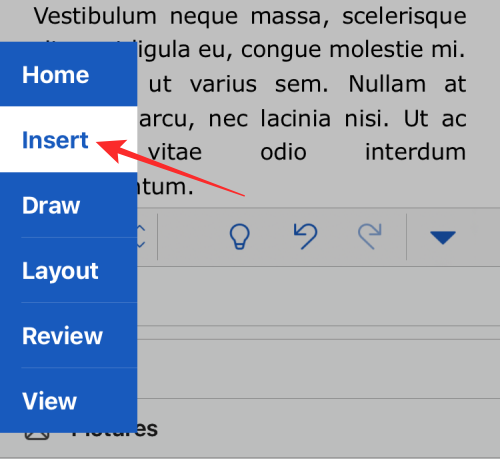
- You can choose to insert tables, pictures, and images directly from your Camera, shapes, text box, icons, 3d models, links, comment, equation, header & footer, footnote, and endnote. You can add any of these elements or multiple ones to your document as per your requirement.
- For instance, if you wish to add an image to the body, select Pictures from inside the Insert tab.

- On the screen that appears, choose a photo you want to add from your iPhone’s Photos app.

- When you add it, your document will now have the picture you inserted.
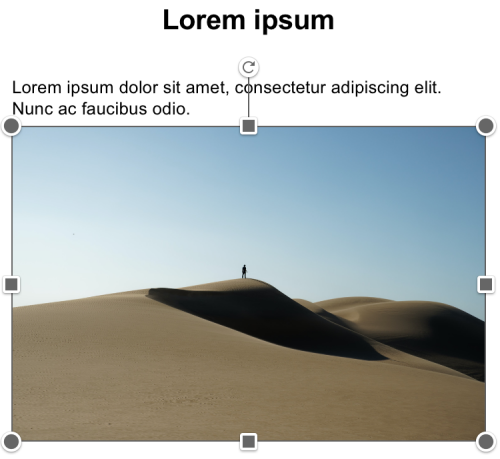
- Similarly, you can insert tables, comments, links, and more elements into your document.
Related: How to Create and Use Photo Shuffle for Lock Screen on iPhone
Draw objects
- Tap on the Draw tab inside the Edit text tool.

- Here, you’ll be able to draw anywhere over the document, select it, and move it around.

Change margins, orientation, size, columns, and breaks
- When you select the Layout tab inside the Edit text tool, you’ll see additional options to change how the text appears inside your document.

- These include the following options:

Margin: Selecting this will reveal more options that you can set as your page margins at the top, bottom, left, and right.

Orientation: Inside this section, you can choose the orientation of your document and toggle between portrait and landscape mode.

Size: Here, you choose the size of the document’s pages. You can choose from the following options – Letter, Legal, A3, A4, A5, JIS B4, and JIS B5.

Columns: When you select this option, you get to choose how many columns you want to align text into a single page of your document. You can choose from the following settings to apply to your page – one, two, three, left, and right.

Breaks
This section is where you configure the page breaks and section breaks of the document you’re editing.
- You can choose from the following options when switching pages – Page, Column, and Text Wrapping.

- When switching sections, you can apply the following options – Next Page, Continuous, Even Page, and Odd Page.

Review document with proofing, lookup, and word count
- You can select the Review tab inside the Edit text tool to get more options to spellcheck and correct the language in your document.

- Once you’re here, you’ll get options to proofread, look up, read, comment, track changes, approve/reject a correction, or check the word count.

Toggle layout, headings, ruler, and zoom
- When you select the View tab inside the Edit text tool, you’ll see options to change how the document appears on your screen instead of changing its appearance.
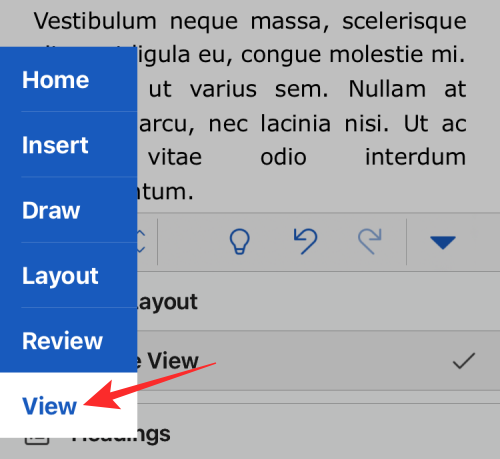
- You can choose to toggle the page view for the document between Print Layout and Mobile View, apply headings, enable/disable ruler, and zoom in/out of the document in view.

That’s all there is to know about editing a Word document on an iPhone.
RELATED

![How to Edit a Word Document on iPhone [AIO]](/content/images/wp-content/uploads/2022/07/how-to-edit-a-word-document-on-iphone1.png)











Discussion